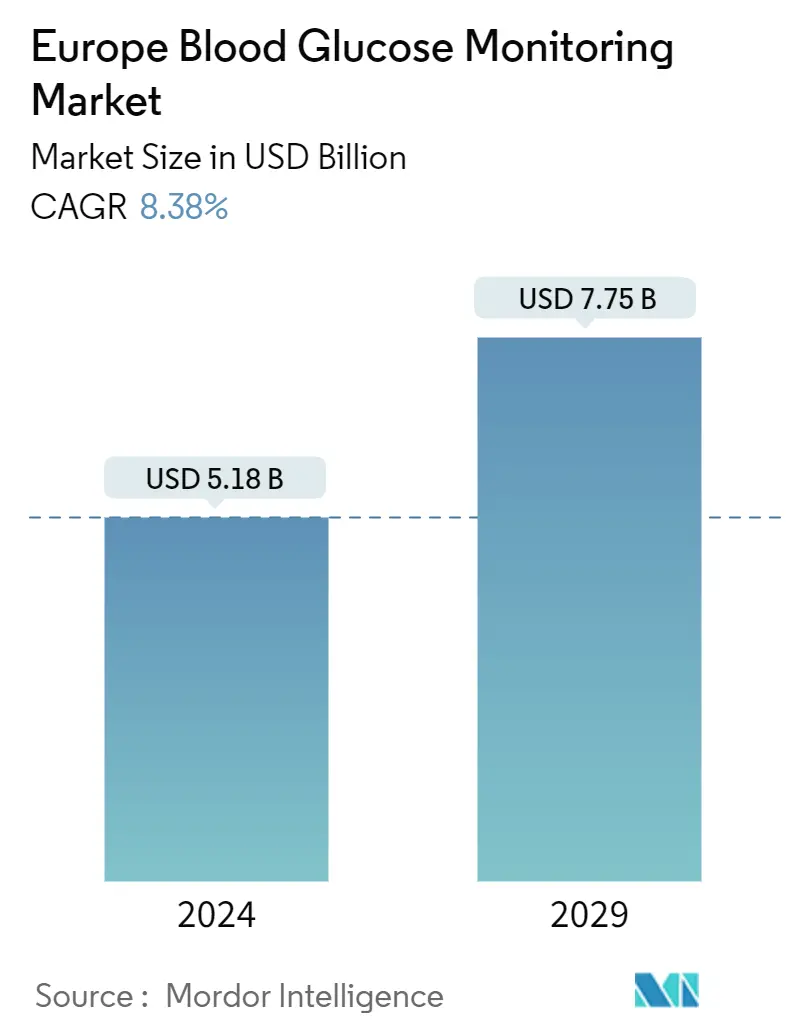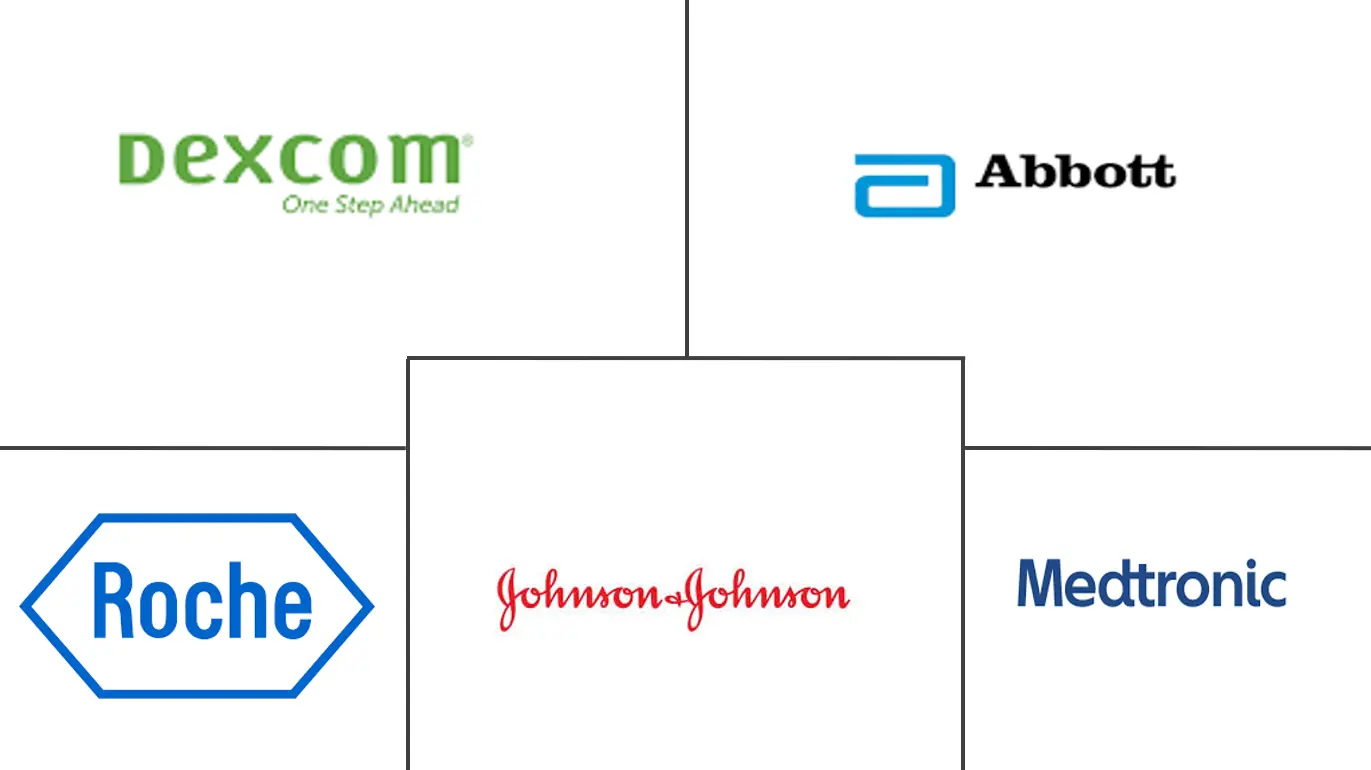Market Size of Europe Blood Glucose Monitoring Industry

| Study Period | 2019 - 2029 |
| Base Year For Estimation | 2023 |
| Forecast Data Period | 2024 - 2029 |
| Market Size (2024) | USD 5.18 Billion |
| Market Size (2029) | USD 7.75 Billion |
| CAGR (2024 - 2029) | 8.38 % |
Major Players
*Disclaimer: Major Players sorted in no particular order |
Europe Blood Glucose Monitoring Market Analysis
The Europe Blood Glucose Monitoring Market size is estimated at USD 5.18 billion in 2024, and is expected to reach USD 7.75 billion by 2029, growing at a CAGR of 8.38% during the forecast period (2024-2029).
The COVID-19 pandemic has substantially impacted the blood glucose monitoring market. Type-1 diabetes patients are impacted more during Covid-19. People with diabetes have a weak immune system, so, with COVID-19, the immune system gets weaker very fast. People with diabetes will have more chances of serious complications than normal people.
According to the diabetes category, the estimated cost per hospital admission during the first wave of COVID-19 in Europe ranged from EUR 25,018 for type 2 diabetes patients in good glycaemic control to EUR 57,244 for type 1 diabetes patients in poor glycaemic control, reflecting a higher risk of intensive care, ventilator support, and a longer hospital stay. The estimated cost for patients without diabetes was EUR 16,993. The expected total direct expenditures for COVID-19 secondary care in Europe were 13.9 billion euros. Diabetes treatment thus accounted for 23.5% of total expenditures.
The European countries are suffering from the burden of high diabetes expenditure. According to the IDF, the overall diabetes expenditure in Europe among the population aged 20-79 years was USD 156 billion, and it is expected to increase to USD 174 billion by 2040. According to other statistics from IDF, every year, 21,600 children are added to the type-1 diabetic population pool. These figures indicate that approximately 9% of the total healthcare expenditure is spent on diabetes in Europe.
With the advancements in technology, blood glucose meters have evolved to include cellular-connected devices. These devices automatically upload self-monitoring blood glucose (SMBG) data to secure cloud-based databases. This allows for improved sharing and monitoring of SMBG data. Real-time monitoring of SMBG data presents opportunities to provide timely support to patients who have abnormal SMBG recordings.
Diabetes remote monitoring programs that utilize these technological advancements can offer additional support to patients with poorly controlled diabetes. This support can significantly improve critical outcomes and enhance market prospects in the future.
For patients relying on insulin pumps or multiple daily injections (MDI) therapy, the CGMs are an effective tool that helps improve glycemic balance without aggregating the danger of severe hypoglycemia.
Therefore, owing to the aforementioned factors, the studied market is anticipated to witness growth over the analysis period.
Europe Blood Glucose Monitoring Industry Segmentation
One of the greatest methods to comprehend diabetes and how various meals, drugs, and activities affect diabetes is to test your blood sugar levels. Monitoring blood glucose levels can assist a doctor in creating a management strategy for this illness. Europe's human insulin drugs market is segmented into drugs and geography. The report offers the value (in USD) and volume (in units) for the above segments.
| Self-monitoring Blood Glucose Devices | |
| Glucometer Devices | |
| Test Strips | |
| Lancets |
| Continuous Glucose Monitoring | |
| Sensors | |
| Durables |
| Geography | |
| France | |
| Germany | |
| Italy | |
| Spain | |
| United Kingdom | |
| Russia | |
| Rest of Europe |
Europe Blood Glucose Monitoring Market Size Summary
The Europe Blood Glucose Monitoring Market is poised for significant growth, driven by technological advancements and an increasing prevalence of diabetes. The market is characterized by the evolution of blood glucose meters into cellular-connected devices, enabling real-time monitoring and data sharing through secure cloud-based systems. This innovation facilitates timely support for patients with abnormal self-monitoring blood glucose (SMBG) readings, enhancing patient outcomes and market prospects. Continuous glucose monitoring (CGM) devices, which provide detailed insights into blood glucose patterns and trends, are becoming more accessible and affordable due to advancements like cell phone integration. These devices are expected to contribute to the market's steady expansion over the forecast period.
The market landscape is highly fragmented, with major players such as Dexcom, Medtronic, Abbott, and Senseonics leading the CGM segment, while companies like Roche, LifeScan, and Arkray dominate the blood glucose monitoring device market. The COVID-19 pandemic has underscored the importance of effective diabetes management, as patients with diabetes face higher risks of severe complications. This has led to increased healthcare expenditures and a heightened focus on diabetes care in Europe. The German market, in particular, is experiencing a rise in diabetes prevalence, prompting initiatives to enhance diabetes management and monitoring. As awareness and demand for advanced monitoring solutions grow, the European blood glucose monitoring market is expected to witness robust growth, supported by ongoing technological innovations and strategic market developments.
Europe Blood Glucose Monitoring Market Size - Table of Contents
-
1. MARKET DYNAMICS
-
1.1 Market Overview
-
1.2 Market Drivers
-
1.3 Market Restraints
-
1.4 Porter's Five Forces Analysis
-
1.4.1 Bargaining Power of Suppliers
-
1.4.2 Bargaining Power of Consumers
-
1.4.3 Threat of New Entrants
-
1.4.4 Threat of Substitute Products and Services
-
1.4.5 Intensity of Competitive Rivalry
-
-
-
2. MARKET SEGMENTATION
-
2.1 Self-monitoring Blood Glucose Devices
-
2.1.1 Glucometer Devices
-
2.1.2 Test Strips
-
2.1.3 Lancets
-
-
2.2 Continuous Glucose Monitoring
-
2.2.1 Sensors
-
2.2.2 Durables
-
-
2.3 Geography
-
2.3.1 France
-
2.3.2 Germany
-
2.3.3 Italy
-
2.3.4 Spain
-
2.3.5 United Kingdom
-
2.3.6 Russia
-
2.3.7 Rest of Europe
-
-
Europe Blood Glucose Monitoring Market Size FAQs
How big is the Europe Blood Glucose Monitoring Market?
The Europe Blood Glucose Monitoring Market size is expected to reach USD 5.18 billion in 2024 and grow at a CAGR of 8.38% to reach USD 7.75 billion by 2029.
What is the current Europe Blood Glucose Monitoring Market size?
In 2024, the Europe Blood Glucose Monitoring Market size is expected to reach USD 5.18 billion.

